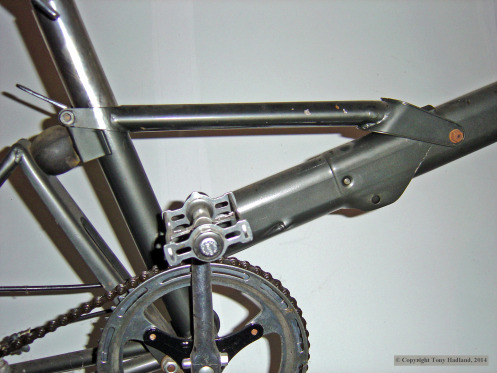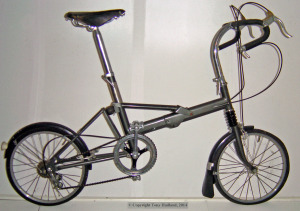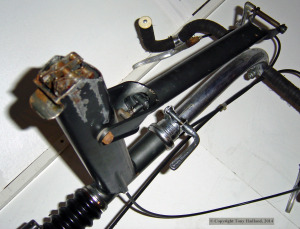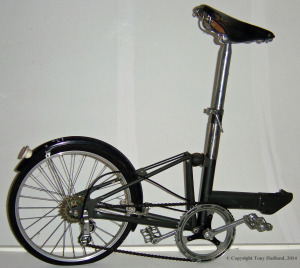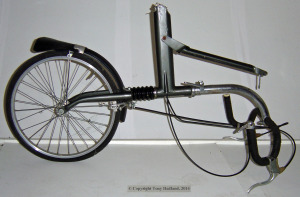Alex Moulton hated the idea that his bicycles would be considered as folding bicycles. He always made the point that his aim was to produce a better bicycle, not a folder. A small proportion of the 1960s Moultons were separable for stowing in the boot of car, as were the majority of his post-1983 spaceframe machines, but Alex never, ever, made a folding bicycle.
A number of people have adapted Moultons into folding bicycles but Alex never did. The question that many Moulton researchers and enthusiasts have asked themselves is “Did he ever, in secrecy, produce a folding prototype?” More than 20 years ago, when I first saw a colour slide in the Moulton archives of the bike featured here, I thought for a few seconds that I had found evidence of just such a machine. But it did not take long to establish that this, too, is a separable machine, albeit a unique variant on the theme.
The original Moulton Stowaway joint, used in a minority of production F-frame Moultons in the 1960s, was very unforgiving if the bike was ridden without the joint bolt being fully tightened. Just one short ride with the bolt loose would distort the joint, making it looser in the vertical plane when ridden yet harder to separate.
In the 1970s, Alex Moulton made a little known attempt to improve the Stowaway joint. The only known example exists in a prototype Mk 4 Moulton. (The Mk 4 was a development of the Mk 3 that never went into production.)
Alex’s aim was to produce a joint that was fail-safe and that would not be damaged if ridden without being fully tightened. The resulting design is shown in the photos below. The front section of the main beam has a primary hook at the lower end of the joint end. This hooks over a peg on the rear section of the main beam. The top of the front section of the main beam bears upon a “hooded” forward extension of rear part of the main beam, thus holding the two parts of the main beam loosely together.
Rather than just relying on the primary hook joint, there is a pair of secondary pivoting hooks within the front section of the main beam. These hook around a peg that runs through the central axis of the rear section of the main beam. To complete assembly of the bike, the frame’s short “carrying handle” is swung into its horizontal position and fastened around the seat tube, just above the squashball suspension unit, using a bolt with a quick-release lever. A cam on the underside of the carrying handle, near its pivot, locks the secondary hooks in position. The combination of the secondary hooks and the bracing effect of the carrying handle make the joint tight in the ridden mode.
To separate the frame, the carrying handle is unbolted and swung forward, which releases the pair of secondary hooks via the cam in the carrying handle. The two parts of the frame can then be separated by releasing the primary hook.
In conclusion, this prototype joint is certainly a belt and braces job but is very complicated, expensive to manufacture and relatively heavy. It is not surprising that it never saw the light of day.
